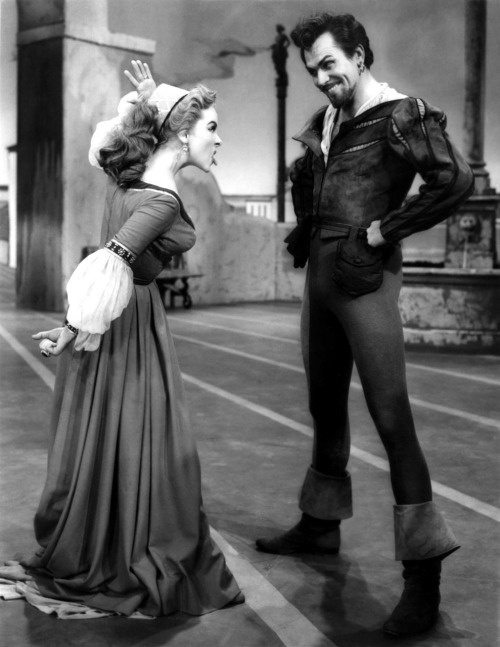Standard elements of Shakespearean comedies:
1. Cross-dressing and disguising -- This one is all over the place in the play, it seems like just about everybody is dressing up as someone else. Already in the induction we have Christopher Sly dressed up as a Lord, and the page dressed up as a woman pretending to be his wife. In the play itself Lucentio and Hortensio dress up as the scholars Cambio and Licio, Tranio then dresses up as Lucentio. They even take the travelling old man and pretend that he is Vincentio, Lucentio's father.
2. Dramatic Irony -- Dramatic Irony is when the audience knows something that the characters on stage do not, usually this used for comedic effect. One of the funniest scenes, in my opinion is the one when the real Vincentio shows up. Because of the disguising and pretending to be other people, everyone thinks that the old guy is Vincentio and Tranio is Lucentio, so when the real Vincentio shows up no one believes him, and he assumes that Tranio has killed his master, the real Lucentio, and taken his place.
3. Marriages, usually at the happy end -- This is where it gets a little interesting, because there is a marriage, but it happens in the middle and it isn't immediately happy, though it becomes happy at the end. But the marriage between Kate and Petruchio is in contrast with the marriage of Bianca and Lucentio. The one happens early and is volatile until the end, where the other is more of the accepted norm, happening at the end between two people who have already fallen in love.
'Nuff said.
5.Social misfits and/or fools --There is often the fool character, or the social misfit, the character that is outside of society and can therefore say and do what he wants without regard to what people think of him. In Taming of the Shrew this role is played by Biondello and Grumio. Both are lower class citizens, servants to Lucentio and Petruchio, and both are very funny characters. I particularly enjoy Grumio's opening scene, where Petruchio asks him to knock him, and Grumio refuses to knock his master. Though the audience can tell that Petruchio meant that Grumio should knock for him at the gate, the actual words that Petruchio uses can be and are construed by Grumio to mean that he should strike his master, which he refuses. It seems that Shakespeare understands the concept of the comic relief which "often takes the form of a bumbling, wisecracking sidekick".
6. Dialogue, usually very witty and full of wordplay -- This is what people usually think of when they think of Shakespearean comedies - the wit and the wordplay. The most obvious example in Taming of the Shrew is Act II, Scene 1 when Kate first meets Petruchio and they engage in verbal sparring. There is so much punning and wordplay in that very quick exchange of dialogue, it is very entertaining for the audience.
7. Multiple storylines -- This is another Shakespearean hallmark, multiple characters with their own storylines that are woven together, usually culminating at the end of the play. Kate and Petruchio have their love story, such as it is, and Bianca and her suitors have theirs, and then each suitor (Gremio, Hortensio, and Lucentio) have their own plots, with both Hortensio and Lucentio dressing up as scholars to sneak in and woo Bianca. But at the end of the play, all of these stories come together with the three happy couples feasting together, Petruchio and Kate, Lucentio and Bianca, and Hortensio with his widow. Poor Gremio just goes along for the free food, it seems, being left without a woman to marry.
8. The pastoral, the green world -- Often in Shakespearean comedies there is at least a scene or two that takes place in nature, in an outside world, away from the ordered and organized city life where wildness and madness occur, often resulting in some sort of metamorphosis. Upon first reading of the play Taming of the Shrew I wondered where this was; the only scene that takes place in what could be called a 'green world' is the short scene where Kate and Petruchio are on the road and they meet Vincentio, but this scene doesn't really fit the function of what the 'green world' does for the play.
One of the primary purposes of the 'green world' is to facilitate a metamorphosis, a changing where a character is allowed to be wild, in a sort of cleansing, purging manner before returning to the city. Do we see this sort of metamorphosis in Taming? Jeanne Addison Roberts believes there is. She writes in her article about Kate being transformed from an 'animal' to a person, and "not only [a person] but a suitable spouse." Kate starts out as a shrew and becomes a wife, but it is interesting to note that this transformation does occur outside the city, in the location described in the script as "Petruchio's country house." Though there is no overt forest scene, like we find in A Midsummer Night's Dream or As You Like It, the country house serves the same purpose for Kate and Petruchio, where they can rail at each other on their way to becoming a good husband and wife.

